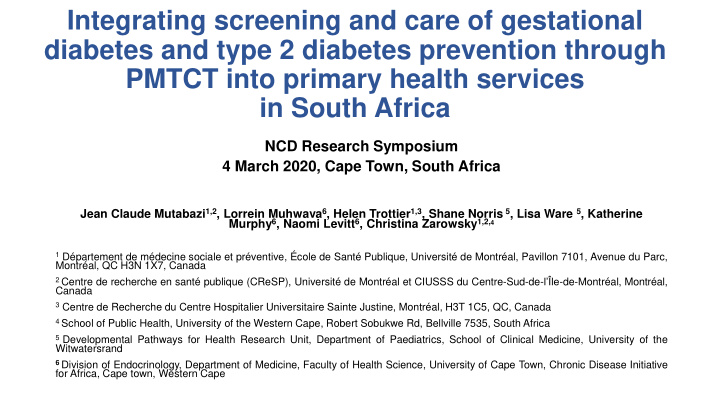



Integrating screening and care of gestational diabetes and type 2 diabetes prevention through PMTCT into primary health services in South Africa NCD Research Symposium 4 March 2020, Cape Town, South Africa Jean Claude Mutabazi 1,2 , Lorrein Muhwava 6 , Helen Trottier 1,3 , Shane Norris 5 , Lisa Ware 5 , Katherine Murphy 6 , Naomi Levitt 6 , Christina Zarowsky 1,2, 4 1 Département de médecine sociale et préventive, École de Santé Publique, Université de Montréal, Pavillon 7101, Avenue du Parc, Montréal, QC H3N 1X7, Canada 2 Centre de recherche en santé publique (CReSP), Université de Montréal et CIUSSS du Centre-Sud-de- l’Île -de-Montréal, Montréal, Canada 3 Centre de Recherche du Centre Hospitalier Universitaire Sainte Justine, Montréal, H3T 1C5, QC, Canada 4 School of Public Health, University of the Western Cape, Robert Sobukwe Rd, Bellville 7535, South Africa 5 Developmental Pathways for Health Research Unit, Department of Paediatrics, School of Clinical Medicine, University of the Witwatersrand 6 Division of Endocrinology, Department of Medicine, Faculty of Health Science, University of Cape Town, Chronic Disease Initiative for Africa, Cape town, Western Cape
Background Prevention of Mother to Child Transmission (PMTCT) programmes have been successfully integrated into primary health care. PMTCT programmes have influenced other maternal and child health services in South Africa. Some women under PMTCT care are also diagnosed with gestational diabetes (GDM).
Background GDM increases risk for type 2 diabetes (T2D) for women and their babies. GDM is managed at tertiary level in South Africa. GDM management among HIV infected women has not been studied.
Obje jectives To assess extent of integrating GDM and T2D prevention into PMTCT cascade in Western Cape. To explore how PMTCT integration experience in South Africa might bridge gaps in managing GDM and T2D for women and their exposed babies.
Methods Mixed methods were used. analysis of policy documents on PMTCT and PNC. Time-series analysis of 2012-2017 PMTCT data for Western Cape province. Semi-structured interviews: • 10 national and local PMTCT experts. • 10 clinic managers, nurses and midwives in disadvantaged facilities. • 10 HIV-infected women diagnosed with GDM in Cape Town. Atlas.ti software was used to assist thematic analysis.
Results o Policy documents emphasised comprehensive ANC including HIV counselling and testing (HCT) and treatment initiation. o GDM and other major NCD screenings were not adequately included in Both ANC and PNC policies. o Both policies mainly focused on HIV services.
Results Participant characteristics N (%) Participant category Experts 10 (50) FHCWs: Clinic managers 3 (15) Nurses and midwives 7 (35) Sex Female 16 (80) Male 4 (20) Age mean and SD: Experts 49.8 - FHCWs 40.1 - Overall mean (SD) 44.9 (8.2) -
Results All participants underlined the importance of integrated PMTCT. GDM screening and subsequent interventions to prevent or delay T2D were not included into PMTCT. All women interviewed wanted their GDM screening and management through PMTCT services. Most experts (80%) and clinic staff (70%) agreed on the feasibility of GDM and T2D integration. More staff recruitment, adequate training, managerial support and infrastructure expansion are crucial for successful integration.
Conclusion Integration, HIV and NCDs are department of health priorities. Integrating GDM screening/care and T2D prevention into PMTCT services, with potential expansion in other PHC services, is not currently occurring. INTEGRATION is possible and can improve experienced quality of care and reduce tertiary care burden.
Acknowlegdements • We gratefully acknowledge: The the Canadian Institutes for Health Research (CIHR) for funding this PhD research UdeM, CReSP, CHU Sainte Justine, IINDIAGO and CDIA administrative team Study participants who provided useful information for this study.
Thank you Any questions?
Recommend
More recommend